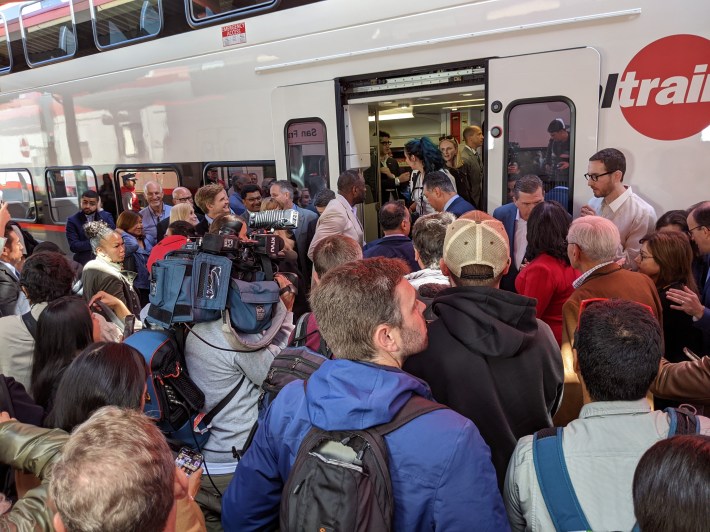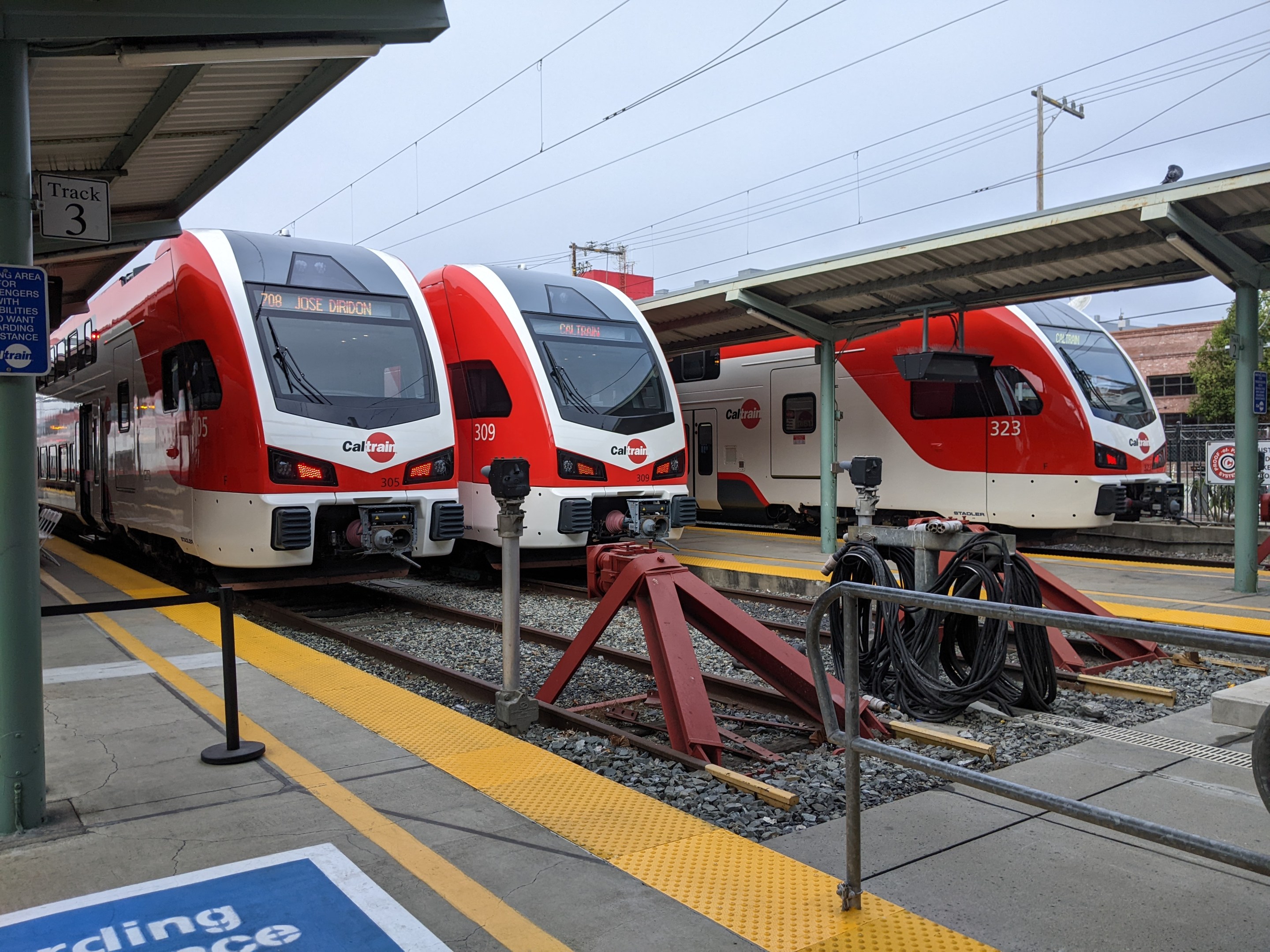Note: GJEL Accident Attorneys regularly sponsors coverage on Streetsblog San Francisco and Streetsblog California. Unless noted in the story, GJEL Accident Attorneys is not consulted for the content or editorial direction of the sponsored content.
Caltrain celebrated the launch of electric train service Saturday morning during a VIP event at 4th and King station. From a Caltrain release:
The event included a 30-minute round-trip experience, starting in San Francisco with the opportunity to engage with federal, state, local elected officials as well as transportation, business, labor and community leaders. Sunday, August 11, the electric trains will run their first regular service. Additional electric trains will be introduced every week until the launch of the new schedule and full electrified service between San Francisco and San Jose on Saturday, September 21.
For now, the electric trains will be mixed into the existing schedule with the old diesels, so riders might randomly find themselves boarding one. "You won't hear them coming because they'll be sooo quiet," said San Francisco Mayor London Breed, one of the speakers at the event. The completion of the $2.72 billion project is a sign that "San Francisco is alive and well despite what people say," said State Senator Scott Wiener. "This project is beautiful," he added, looking back at the sleek new trains lined up behind him.

"This is about jobs, jobs, jobs," said Speaker Emeritas Nancy Pelosi, stressing the economic add-on benefits of making it easier to zip up and down the Peninsula. "I'm talking about the jobs to build it, to run it, and the jobs that spring from running it."

While the politicians celebrated their contributions in raising funds for the project, the people who actually make the trains run waited quietly in the wings. Streetsblog asked Ronny Hassig, with Stadler, the company that built the trains, if he was worried if the trains would perform as promised. "No, I'm not. Not any more," he said. "We're here just to check some details." And to make sure the trains are clean for the event, said the Stadler employees.


Advocates were on hand too, including Clarrissa Cabansagan of the Silicon Valley Bicycle Coalition who, of course, started her tour with the bicycle car.

Cabansagan said she was happy with the flip seats in the bike car so riders could sit with their steeds and keep an eye on them. Adina Levin of Green Caltrain and Seamless Bay Area was also on hand. Levin was concerned about maintaining operational funding to keep a high level of service. She remarked that the acceleration was noticeably "zippy."

The train took the invited VIPs on a quick dash down to Millbrae and back, hitting 83 mph along the way and averaging 57. The trains are capable of 110 mph, according to an official at the event, but it'll be a few years before their full potential is realized when high-speed trains from the Central Valley start to operate on the corridor as well. That's going to require more upgrades to grade crossings, signals, and some adjustments to the catenary. But that doesn't mean big benefits won't be seen in September when Caltrain introduces its new schedule. Local trains will operate in 75 minutes, compared to 100 minutes today between San Jose and San Francisco. That's because of the enormous advantage these trains have in acceleration. Caltrain made this video of a diesel and electric accelerating over the same period to illustrate:
More details from Caltrain:
The new high-performance electric trains offer a better experience for Caltrain riders while providing faster and more frequent service. Express service will allow commuters to travel between San Francisco and San Jose in under an hour. The new trains will also increase service by 20% because they can accelerate and decelerate much faster than diesel trains. This provides more robust and flexible access to cities throughout the rail system, with 16 stations seeing trains every 15-20 minutes at peak hours and all stations receiving service every 30 minutes on the weekend compared to hourly service today. Additionally, electrified service will advance equity along the corridor by reducing noise and air pollution while increasing access and service for equity priority communities by 26%.
So how was the ride? The trains are indeed quieter, much smoother, and the improved acceleration out of stations is noticeable. The trains feel much roomier and brighter than the Caltrain equipment they're replacing. One concern: there's only one toilet per train set. As some of the personnel on board remarked, that's a decision that is likely to backfire as beer-laden Giant's fans head home from games. Transit advocates fought to get one bathroom installed, as apparently the agency originally wanted the trains to be without on-board bathrooms at all, much like BART.

That issue aside, from Streetsblog's view it was nice to ride what felt like a modern train of the type so familiar to anyone in Europe (the trains are essentially off-the-shelf Stadler KISS trainsets from Switzerland and are ubiquitous overseas). The difference in the rider experience between these trains and the heritage fleet is remarkable and with the increased schedule planned for next month, this is bound to make a real change in how people get around the Peninsula.
For now, service to Gilroy will continue to be diesel-hauled. But officials at the event were already talking about extending electric service to Gilroy and even Salinas (which currently has no Caltrain service) with the development of trains that can charge batteries while running under wire and then continue past the end of electrification. Let's hope Amtrak's Capitol Corridor, L.A.'s Metrolink, and other services throughout the state are paying attention.
More pictures of the trains and the event below:









